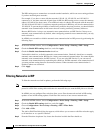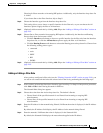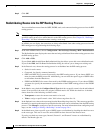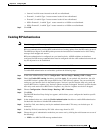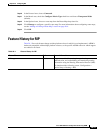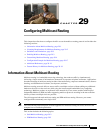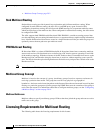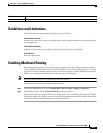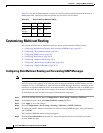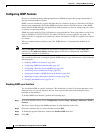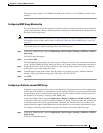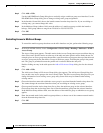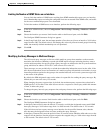
29-2
Cisco ASA 5500 Series Configuration Guide using ASDM
Chapter 29 Configuring Multicast Routing
Licensing Requirements for Multicast Routing
• Multicast Group Concept, page 29-2
Stub Multicast Routing
Stub multicast routing provides dynamic host registration and facilitates multicast routing. When
configured for stub multicast routing, the ASA acts as an IGMP proxy agent. Instead of fully
participating in multicast routing, the ASA forwards IGMP messages to an upstream multicast router,
which sets up delivery of the multicast data. When configured for stub multicast routing, the ASA cannot
be configured for PIM.
The ASA supports both PIM-SM and bidirectional PIM. PIM-SM is a multicast routing protocol that
uses the underlying unicast routing information base or a separate multicast-capable routing information
base. It builds unidirectional shared trees rooted at a single Rendezvous Point per multicast group and
optionally creates shortest-path trees per multicast source.
PIM Multicast Routing
Bi-directional PIM is a variant of PIM-SM that builds bi-directional shared trees connecting multicast
sources and receivers. Bi-directional trees are built using a DF election process operating on each link
of the multicast topology. With the assistance of the DF, multicast data is forwarded from sources to the
Rendezvous Point, and therefore along the shared tree to receivers, without requiring source-specific
state. The DF election takes place during Rendezvous Point discovery and provides a default route to the
Rendezvous Point.
Note If the ASA is the PIM RP, use the untranslated outside address of the ASA as the RP address.
Multicast Group Concept
Multicast is based on the concept of a group. An arbitrary group of receivers expresses an interest in
receiving a particular data stream. This group does not have any physical or geographical
boundaries—the hosts can be located anywhere on the Internet. Hosts that are interested in receiving data
flowing to a particular group must join the group using IGMP. Hosts must be a member of the group to
receive the data stream. For information about how to configure multicast groups, see the “Configuring
a Multicast Group” section on page 29-14.
Multicast Addresses
Multicast addresses specify an arbitrary group of IP hosts that have joined the group and want to receive
traffic sent to this group.
Licensing Requirements for Multicast Routing
The following table shows the licensing requirements for this feature:



